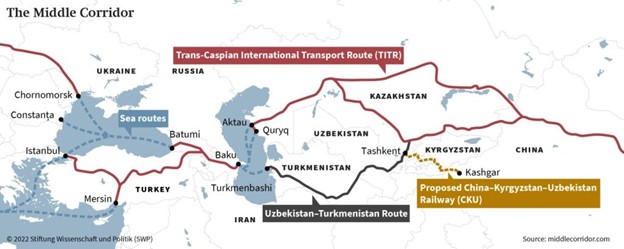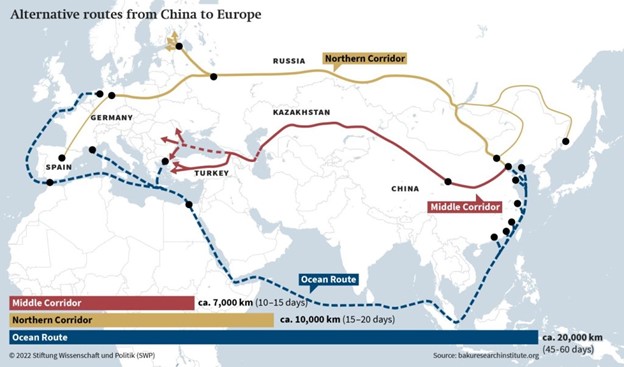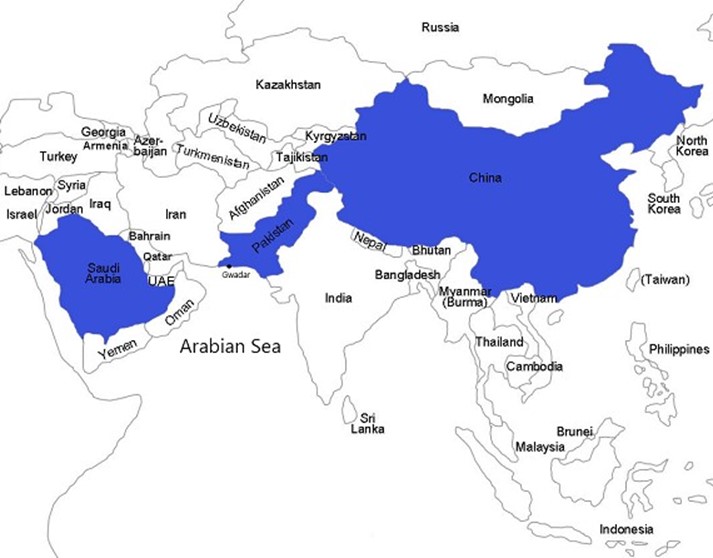Farshad Adel; Chair of the Silk Road Research Group
Introduction
The author of these lines argues in a note in “Contemporary World” that European discoveries in the 15th century led to the discovery of new sea routes that connected Europe with other parts of the world. These new routes opened up new possibilities for the Western world and led to profound transformations in a variety of fields. It was only after this event that Europe transitioned from being the “endpoint of the Silk Road” to being the “origin of global changes.”
The discovery of sea routes not only generated wealth and power for European countries but also paved the way for the acquisition of new lands that soon became known as the “New World.” These new lands became a new center of gravity that attracted a new worldview. This new worldview, in which wealth generation and technological development were considered the most fundamental values for progress, spread from Western Europe to the Americas, not through land routes as in the past, but through sea routes. This new worldview laid the groundwork for the rise of a new superpower called the United States in the contemporary era. The Western axis, led by the United States, introduced a new model of development and wealth generation based on maritime trade that continues to this day.
After the economic and industrial rise of Asian powers such as China and India in recent years, geopolitical and geoeconomic competitions in the world have entered a new era. A new era that can be seen as reminiscent of the era of the flourishing of land routes, which for centuries was the main source of power and wealth in Asia the code name “Silk Road” brought prosperity and prosperity for cities along these land trade routes, from Xi’an and Kashgar and Samarkand and Bukhara to Merv and Ray and Baghdad.
This new era, which firmly established itself after 2013 and the official announcement of China’s Belt and Road Initiative to reach new markets in the West, has paved the way for important movements and actions by the countries of the region, and each one is trying to ensure its share of political, economic, and cultural interests in the “Era of Corridors” with its unique strategies and initiatives. These efforts have led to widespread competition in the commercial, economic, and infrastructural fields, which will ultimately bring a form of development based on the integration of economic interests to the countries involved. This development in the economic sphere will also have an impact on the political and cultural aspects.
The emergence of such conditions for Iran, as one of the most important routes in the history of land trade routes, is an opportunity to regain its central role and influence regional and international trends. However, it is important to note that opportunities are not always present and will be lost if necessary measures are not taken to take advantage of them. Despite the geographical importance of Iran and its historical role in connecting different climates, with the development of tools, there is a serious possibility of ignoring Iran’s historical and geographical role in the present period. Such an event means Iran’s withdrawal from the establishment of railway, road, digital, and energy connections between different countries in the future world. Such an event will turn Iran into an “invisible country” in the region in the not-too-distant future.
The existence of such a great danger speaks of the great opportunities that are available to Iran in the age of corridors to recreate its historical and geographical role in the present era with unique initiatives and strategies. This opportunity is available to Iran more than any other country to be the main winner of the corridor war in the West Asia region by relying on its civilizational history, geographical location, and benefiting from 15 neighbors.
This has been ignored to date, and in the absence of Iran, Turkey has been responsible for creating an initiative in this process. This country, especially after the Ukraine war, is trying to use the closure of Russia’s borders with Europe to highlight its role as the main route of access from east to west, using the middle corridor. Alongside Turkey, the Gulf countries are also trying to develop relations with China to create a connection between East Asia the Mediterranean, and North Africa. Other countries, such as Pakistan, are also active players in the “corridor war” by using strategic partnerships with China.
The Corridor War: A Battle of Innovation and Strategy
The use of the word “war” to describe economic competition may seem a bit far-fetched. However, it should be noted that the potential for economic and political benefits in the field of rail, road, and energy corridors is so significant that countries view it as a war for the greatest benefit. This can even lead to military conflicts, as we saw in 2020 in the conflict between Armenia and Azerbaijan.
Despite the long-standing tensions between Armenia and the Republic of Azerbaijan, recent developments in the Caucasus must be analyzed in the context of the corridor war. A conflict in which Turkey is trying to use Azerbaijan as a tool to provide direct east-west access from Central Asia to the Mediterranean. This strategy, which will strengthen the middle corridor as part of the Trans-Caspian Initiative, will allow Turkey to become the main route of connection between East and West.
Turkey’s Middle Corridor Initiative: A Strategy for Expansion in Central Asia
The Middle Corridor is an initiative that provides connectivity between Turkey and China via Georgia, Azerbaijan, the Caspian Sea, and then Kazakhstan or Turkmenistan, Uzbekistan, and Kyrgyzstan. According to the Asian Development Bank, the two main access routes for the Middle Corridor initiative are the Trans-Kazakhstan Railway, which after its completion in 2014, covered 1,000 kilometers of the east-west transportation route across the country; and the Baku-Tbilisi-Kars (BTK) railway, which became operational in 2017. The BTK railway, or “Iron Silk Road,” made direct rail transportation possible between the Caucasus region and Turkey after the rail link between Armenia and Turkey was closed as a result of the conflict between Armenia and the Republic of Azerbaijan in the early 1990s.

The connection of this transit route between Azerbaijan and Turkey, in addition to being an effort to shorten the route from China to Europe, also increased the connection between Turkey and the countries of Central Asia and the South Caucasus. From Ankara’s perspective, the Middle Corridor is a very attractive trade route as it not only creates a connection between Turkey and Central Asia but also reduces the dependence of Central Asian countries on Russia and Iran.
The origin of this initiative dates back to 2009 and was proposed by Fatih Jillian. Turkey’s main goal for launching the Middle Corridor Initiative is to create a multimodal route that connects Europe and Asia and increases regional cooperation with countries along the Trans-Caspian. To this end, various port routes have been planned that transport cargo from origin to destination using multiple modes of transportation, in a combined manner but under a single contract or bill of lading. Examples of the benefits of transit from the Middle Corridor route include stopover services, efficient freight tracking, and minimizing logistics coordination costs.

Turkey aims to attract 30% of the cargo that passes through the Trans-Siberian Corridor to the Middle Corridor. Through bilateral, trilateral, and multilateral initiatives, Turkey seeks to benefit from its geographical location in the heart of the Europe-Asia-Africa trade triangle.
Although Turkey initially faced challenges in persuading the countries of Central Asia to join the Middle Corridor initiative, including Russian influence, the country’s propaganda and narrative-building about its hard and soft power led to the countries of Central Asia becoming interested in cooperating with Ankara after Western sanctions were imposed against Russia. This will create new opportunities for Turkey to increase its influence in the Central Asia region.
Accordingly, the Turkish government pays special attention to “creating a superiority narrative” in various cultural and military fields. Emphasis on Turkish identity and the adoption of Pan-Turkic policies, as well as exaggeration and exaggeration in the military field by conducting noisy maneuvers and operations in the Caucasus, North Syria, and the war in Ukraine, as well as emphasizing the power of Turkey’s UAV capabilities in the war in Ukraine, are all examples of a superiority narrative that create new commercial and political opportunities for Turkey.
In addition to this, Turkey is trying to establish strategic and deep cooperation with the countries of Central Asia by adopting “expansion diplomacy.” This diplomacy, which has emerged and developed in the framework of the Organization of Turkic States, provides a glimpse into the development of relations between Turkey, Azerbaijan, and the countries of Central Asia, as a result of which Turkey will have a high capacity to influence the regions of the Caucasus and Central Asia. The essential role of the Middle Corridor initiative in shaping such convergence is one of the most important examples for understanding the importance of transit routes and energy lines.
CPEC Corridor: A Platform for Joint Cooperation between China, Pakistan, and Saudi Arabia
The China-Pakistan Economic Corridor (CPEC) was initially an exclusive initiative by China and Pakistan to provide China with access to Pakistan’s important ocean port in Gwadar. Despite the interest of both countries in attracting international cooperation from various countries, the implementation of agreements related to CPEC will still be exclusive to China and Pakistan. However, with Saudi Arabia’s interest in investing in Gwadar port, this country may also become the third side of this initiative. It can be predicted that with the entry of Saudi Arabia into the development of the CPEC corridor, this country will become a strategic ally for China to expand one of the main routes of the Belt and Road initiative, which will provide China with access to the markets of the Middle East and Africa. It should be emphasized that a presence in Africa is an important and long-term goal for China, as the population growth of this continent presents a favorable outlook for new markets for China. A market that will include more than a quarter of the world’s population by 2050. Accordingly, China’s view of Saudi Arabia as a strategic ally is likely to be a logical assessment.

Saudi Arabia’s participation in the development of the main route from the southern corridor of the Belt and Road Initiative will bring various benefits to China. First, Saudi Arabia can ensure China’s energy security, which is the consumer of more than a quarter of the global energy supply. Cooperation in the field of energy is one of the most important issues that is important to all three parties to this cooperation. This cooperation will be concentrated on Saudi Arabia’s refinery investments in Gwadar under the name of “Oil City” and will turn Pakistan into a hub to provide the energy needed by China.
On the other hand, Saudi Arabia’s active participation in this initiative can pave the way for the entry of other Arab countries into the Belt and Road Initiative, and there are currently plans to connect the railway lines of the Gulf Arab countries to the CPEC corridor. We will likely see more actions in this regard shortly.
Of course, it is necessary to mention that despite the high-level and good relations between China and Arab countries, including Saudi Arabia and the United Arab Emirates, the development of Arab investments in Gwadar will mean a reduction in China’s influence in this port and in general in Pakistan. This issue is likely to lead to China more carefully monitoring these investments.
Iran, Prone but Passive: Lack of a National Grand Strategy in the Corridors
Despite Iran’s prominent role in the history of land trade routes and the remaining signs of the prosperity of commercial routes in the Greater Iranian region, in the present era, Iran cannot be considered an active player in the corridor war. The main reason for this passivity is the lack of a national grand strategy for Iran to benefit from the current benefits in international transit routes. These benefits, despite generating wealth, will increase Iran’s strategic power more than they are material.
Currently, Iran has not offered any initiative in the field of corridors to the world, and Iran’s only activity in this field is related to the North-South Corridor. This activity has also taken on a relatively serious shape after 22 years and only after the war between Russia and Ukraine. However, shaping this corridor also requires solving various hardware and software problems in the field of transit.
Despite the importance of the North-South Corridor, this corridor cannot be considered the most important corridor passing through Iran. Iran’s corridor strategy must include various dimensions that provide the necessary ground for creating rail, road, and maritime communications, as well as links in the energy and digital sectors with neighboring countries.
Summary
**Based on the above, it is necessary to take the following steps for Iran to become an active player in the corridor war:
- First, Iran needs to develop a national grand strategy for corridors that is based on a unique initiative. This strategy should be developed through the use of “road diplomacy” as a complement to Iran’s neighborhood policy and its Look East strategy.
- Second, Iran needs to address the software problems and legal barriers that hinder the flow of goods through the country.
- Third, Iran needs to establish a single entity to oversee corridor-related activities to eliminate the coordination problems that arise from the multiplicity of organizations and decision-makers involved in transit.
The opportunities created by the corridor war are not eternal. Various initiatives in the region are trying to diminish Iran’s historical role as a bridge between East and West. If these efforts succeed and Iran continues to be passive in the corridor war, it will not affect Iran’s political, economic, and cultural role in regional and international developments. In the long run, Iran will become a country that is invisible in the heart of the world.
To overcome this danger, “road diplomacy” is a solution that can increase Iran’s power and wealth by negating existing inefficiencies and emphasizing Iran’s historical and geographical capacities.**


